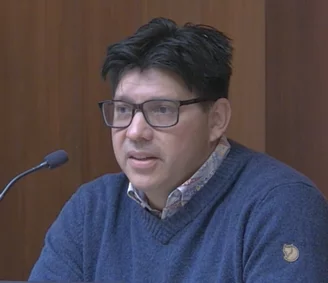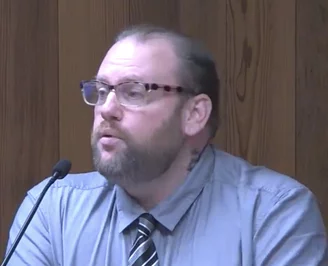###
The City of Eureka held a Community Health Town Hall this morning to discuss some of the issues surrounding substance use disorder in our community and explore strategies to help struggling individuals find supportive care without stigma.
“This is a really important topic because I think there’s so many misconceptions and so many myths about addiction and substance use,” Eureka Mayor Kim Bergel said at the beginning of today’s town hall. “It’s a tough one sometimes to talk about. I just want to remind folks that substance use – this is one of the myths – is not a moral issue. … Substance use does not discriminate. It doesn’t care if you live on a hill with a lot of money or if you live on the street – substance use doesn’t care.”
One of the panelists, Dr. David Villasenor, a psychiatrist with the Eureka Veterans Administration, said the solution to addiction is “super simple,” but stopping the abuse is where it gets complicated.
“The pathway to that solution is very difficult and can be very convoluted and confusing, but there is always hope in addiction,” he said. “I’d like to say that some people in recovery are some of the wisest people I know. They have a profound understanding that the onus of control is theirs, that they have to make the decision … and other people who don’t have that challenge really never face their demons and have to make that personal change in such a profound way.”
However, individuals struggling with substance use disorder have co-occurring mental health conditions that can make treatment more difficult and even lead to further abuse, said Wes Harrison, executive director of Crossroads Recovery in Eureka.
“Each exacerbates the other,” he said. “Mental health – if left untreated – will feed into substance use behavior and then that substance use behavior will exacerbate the mental health and will very quickly and rapidly decline an individual’s quality of life, which will often lead to more substance use, criminality, homelessness and even death.”
In recent years, the local and national addiction crisis has been driven largely by the proliferation of the synthetic opioid fentanyl. Jacob Rosen, program director of the Crisis Alternative Response of Eureka (CARE) team, asked the panel how fentanyl has changed their approach to substance use disorder.
“I haven’t seen a heroin positivity case in two years … which tells me one very important factor: fentanyl is the drug of choice,” Harrison said. “We had gotten really good at understanding opiate withdrawal and treating heroin use … and we thought all of that knowledge would really prepare us somewhat for fentanyl. … What we didn’t know was just how difficult the detox portion of fentanyl was going to be.”
Providers didn’t know how long fentanyl would stay in a user’s system, Harrison said.
“We were used to opiates getting out of a person’s system within three to five days, which meant you could detox in that period of time,” he continued. “What we’re seeing now is fentanyl staying in people’s systems for up to two weeks after their last use. Their detox is lasting 10 days.”
Rio Dell Chief of Police Greg Allan said he couldn’t remember the last time he encountered heroin. “Fentanyl is the big one right now and it’s hard to combat it.”
One of the issues with fentanyl – and even more so with Xylazine, a powerful non-opioid sedative that is sometimes mixed with fentanyl – is its resistance to naloxone, also known by its brand name Narcan, an opioid antagonist medication used to reverse an opioid overdose.
“[Fentanyl] is a high-potency synthetic opioid 100 times more potent than heroin, and all of our treatments are calibrated to heroin,” said Villasenor. “We have this drug that’s only been around a couple of years and we still don’t have a good protocol.”
Vesta Wunner, a behavioral health clinician with the Humboldt County Department of Health and Human Services, said it often takes more than one canister of naloxone to save someone from overdosing on fentanyl and encouraged people – everyone – to carry several doses at any given time.
“This is going to save your life in an overdose emergency,” Wunner said, holding a box with the “NARCAN” label. “You may need four or five of these. If you have an opioid or synthetic opioid addiction, medically assisted treatment has a variety of drugs that can help somebody maintain sobriety over time, but that’s not Narcan. That’s methadone and suboxone, and those – just like somebody who has diabetes – a medication that can stabilize a person while they’re getting other kinds of treatment and support.”
Throughout the discussion, the panel emphasized that substance use disorder must be treated like a disease “because it behaves like a disease.”
“That’s why we say it and repeat it over and over again,” Harrison said. “This moral failing issue – sure, it feels that way because then we get something to blame – but the way substance use disorder works is … it is a brain disorder. It follows the disease model because it behaves exactly like a disease.”
Chief Allan emphasized the importance of humanizing people who struggle with substance use disorder.
“You know, looking down on somebody, thinking that you’re better than them or they’re less than you – I always tell people that one decision in your life could have put you in that same position,” he said. “Think about where you came from, the people around you and those that are suffering in your family and put yourself in that position. Humanizing is a great way to understand what somebody else is going through.
The panel spoke at length about several other issues surrounding substance use disorder and took questions from attendees. Press “play” on the video above if you’d like to watch the full video.
###
If you’re struggling with substance abuse disorder, contact the Substance Abuse and Mental Health Services Administration (SAMHSA) national helpline at 1-800-662-4357.



CLICK TO MANAGE